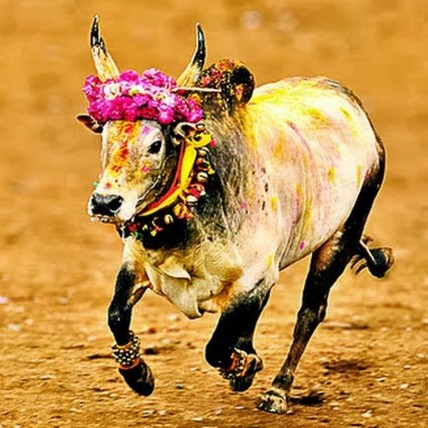Jallikattu ban: It’s destroying an entire culture, say bull owners
The people of Alanganallur near Madurai, home of the now controversial Jallikattu, are in no mood to take the ban on the traditional sport lying down. The entire village of Alanganallur has gone on an indefinite protest fast and in Madurai, some 40 fierce Jallikattu bulls were let loose in the busy hub of Tamukkam.
In Alanganallur, Palamedu and Avaniapuram Pongal festivities have been dampened by the Supreme Court ruling banning the sport which is an integral part of the harvest festival in this region of Tamil Nadu. The mood on the ground is anger against the animal welfare activists who filed a petition calling for the ban.
Jallikattu committee member in Alanganallur V Karthikeyan has announced that “There is nothing left for us to do, but to gather the people and express our displeasure over this ban.”
Others have come out to say that those calling for the ban have, in fact, destroyed a culture. “To us, Jallikattu is not just a sport, it’s the very essence of this soil,” G Chitra, 35, an Alanganallur resident told a newspaper. The sentiment cuts across all sections of people in southern Tamil Nadu. College-goer K Sasikala said, “It is so maddening to see a woman who has no idea about the culture of Tamil Nadu stating on national television that Jallikattu is not part of our tradition.”

Image courtesy: Youtube
There is no doubt that the Jallikattu traces its roots back to the Indus Valley Civilisation when herders mastered the art of controlling straying bulls by holding on to the hump – a distinct feature of the Bos Indicus species of cattle. The practice and demonstration of this skill then became a sport and was known during the Sangam Era as Eru Thazhuvuthal or embracing the bull.
While bull owners and the people of southern Tamil Nadu are enraged by the ban on this ancient sport, experts have expressed the view that there may be other forces at play in this issue. Himakiran Anugula, trustee of SKCRF, an organisation working to conserve native breed cattle in Tamil Nadu wrote in thewire.in: “There were 130 or so cattle breeds in India 100 years ago and now there are only 37. Unless we engage with the traditional livestock keepers and support them, we will lose these breeds as well as lay the ground for commercial cattle-based dairies and slaughter houses to dominate the country… If we look at media reports over the last decade or so, every headline screams about injuries in a Jallikattu event. The focus of the urban editors and reporters has always been on sensationalising news and grabbing eyeballs. Fed with this constant diet over a decade, it’s no surprise that so many internet warriors are shouting about Jallikattu.”
He writes that while the urban media – completely disconnected with rural realities has much to do with the ban — the other group responsible is the dairy lobby, which wants all native breeds to be eradicated. “Events like Jallikattu throw a spanner in their plans of creating commercial dairy farms with imported breeds just like in the West. “Each breed has evolved over several millennia and in a distinct way. One method of breed conservation will not work in another area, with another breed. Every place in the world where indigenous people have lived with their livestock, there are celebratory showcase events post-harvest like kambala buffalo water racing in the Dakshin Kannada region, Ongole stone pulling in central and coastal Andhra, rekla races in western Tamil Nadu and Theni, bailgada in Maharashtra with the Killari breed. Each event has evolved locally and has stood the test of time. In-situ conservation is the best method for conserving any breed. The lifetime and health of the species is extended only due to such events.”
Clearly, we haven’t heard the last word on this debate yet.
Also Read:
Tamil Nadu temple now has the tallest golden tower!
Ban on temple dress code is reversed by the Madras High Court

OMG-inducing, share-compelling, like-attracting, clutter-breaking, thought-provoking, myth-busting content from the country’s leading content curators. read on...
